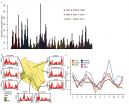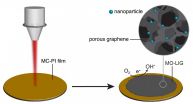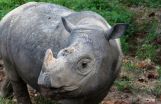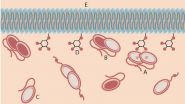(Press-News.org) Scientists studying the 2009 A/H1N1 influenza pandemic have found that the inconsistent regional timing of pandemic waves in Mexico was the result of interactions between school breaks and regional variations in humidity.
The research published in PLOS Computational Biology, led by Dr. James Tamerius at the University of Iowa and Dr. Gerardo Chowell at Georgia State University, applied mathematical models to understand the social and environmental processes that generated two distinct pandemic outbreaks ("waves") in Mexico during the summer and fall of 2009.
The summer wave occurred in the tropical southeastern states of Mexico, whereas the larger fall wave occurred in the central and northern states. The models suggest that high levels of humidity favored the rapid spread of influenza in the tropical states that led to the early summer wave. On the other hand, moderate levels of humidity slowed transmission in the central and northern states precluding a pandemic wave prior to summer break. The summer break reduced the transmission rate by an estimated 14% thereby delaying the pandemic wave in the central and northern states until students returned to school in August. These processes can explain the two major and distinct pandemic waves that affected the different regions.
The relationship between humidity and pandemic influenza transmission found in this study is consistent with the relationship observed for seasonal influenza. This suggests that a greater understanding of the mechanisms that drive inter-pandemic influenza epidemics may increase our capacity to predict the timing of major outbreaks associated with novel pandemic influenza viruses in the future.
All works published in PLOS Computational Biology are Open Access, which means that all content is immediately and freely available. Use this URL in your coverage to provide readers access to the paper upon publication: http://journals.plos.org/ploscompbiol/article?id=10.1371/journal.pcbi.1004337
Press-only preview: https://www.plos.org/wp-content/uploads/2015/08/pcbi.1004337.pdf
Contact: James Tamerius
Address: University of Iowa
Department of Geographical and Sustainability Sciences
University of Iowa
Iowa City, 52245
UNITED STATES
Phone: (520) 780-7650
Email: james-tamerius@uiowa.edu
Citation: Tamerius J, Viboud C, Shaman J, Chowell G (2015) Impact of School Cycles and Environmental Forcing on the Timing of Pandemic Influenza Activity in Mexican States, May-December 2009. PLoS Comput Biol 11(8): e1004337. doi:10.1371/journal.pcbi.1004337
Funding: Funding was provided by the NIH Models of Infectious Disease Agent Study program through cooperative agreement 1U54GM088558 (JT, JS), as well as NIEHS Center grant ES009089 (JS), the RAPIDD program of the Science and Technology Directorate, US Department of Homeland Security (JS), and the in-house influenza research program of the Fogarty International Center, NIH, funded by the Office of Global Affairs' International Influenza Unit,
Office of the Secretary, US Department of Health and Human Services. The funders had no role in study design, data collection and analysis, decision to publish, or preparation of the manuscript.
Competing Interests: JS discloses consulting for JT and Axon Advisors and partial ownership of SK Analytics.
About PLOS Computational Biology
PLOS Computational Biology features works of exceptional significance that further our understanding of living systems at all scales through the application of computational methods. All works published in PLOS Computational Biology are Open Access. All content is immediately available and subject only to the condition that the original authorship and source are properly attributed. Copyright is retained. For more information follow @PLOSCompBiol on Twitter or contact ploscompbiol@plos.org.
About PLOS
PLOS is a nonprofit publisher and advocacy organization founded to accelerate progress in science and medicine by leading a transformation in research communication. For more information, visit http://www.plos.org.
INFORMATION:
Children who have been abused or exposed to other types of trauma typically experience more intense emotions than their peers, a byproduct of living in volatile, dangerous environments.
But what if those kids could regulate their emotions? Could that better help them cope with difficult situations? Would it impact how effective therapy might be for them?
A University of Washington-led team of researchers sought to address those questions by studying what happens in the brains of maltreated adolescents when they viewed emotional images, and then tried to control their ...
PRINCETON, N.J.--Tracking mobile phone data is often associated with privacy issues, but these vast datasets could be the key to understanding how infectious diseases are spread seasonally, according to a study published in the Proceedings of the National Academy of Sciences.
Princeton University and Harvard University researchers used anonymous mobile phone records for more than 15 million people to track the spread of rubella in Kenya and were able to quantitatively show for the first time that mobile phone data can predict seasonal disease patterns.
Harnessing ...
Glenview, Ill. (August 20, 2015)--The popularity of electronic cigarettes has steadily increased worldwide, but little is known about their effects on health. New research suggests that the single use of an electronic cigarette approximating the nicotine exposure of one tobacco cigarette reduces the sensitivity of the cough reflex.
The study tested 30 adult lifetime nonsmokers with no history of asthma or respiratory diseases and used cough tests to determine how e-cigarettes affect the cough reflex. Capsaicin, the pungent extract of red peppers, was used to induce a ...
Medicaid is expected to save billions of dollars a year as patents for several blockbuster antipsychotic medications expire and use of generic versions of these drugs increases, according to a new study by researchers at the University of Maryland School of Medicine. These savings may provide relief from the high costs of these medications and allow policymakers to lift restrictions on patients' access, the researchers argue.
The study forecast that annual Medicaid payments for antipsychotic medicines will decrease by nearly $1.8 billion (or nearly 50 percent) by 2016 ...
HOUSTON - (Aug. 20, 2015) - Rice University chemists who developed a unique form of graphene have found a way to embed metallic nanoparticles that turn the material into a useful catalyst for fuel cells and other applications.
Laser-induced graphene, created by the Rice lab of chemist James Tour last year, is a flexible film with a surface of porous graphene made by exposing a common plastic known as polyimide to a commercial laser-scribing beam. The researchers have now found a way to enhance the product with reactive metals.
The research appears this month in the ...
Leading scientists and experts in the field of rhino conservation state in a new paper that it is safe to consider the Sumatran rhinoceros extinct in the wild in Malaysia. The survival of the Sumatran rhino now depends on the 100 or fewer remaining individuals in the wild in Indonesia and the nine rhinos in captivity.
Despite intensive survey efforts, there have been no signs of the wild Sumatran rhinoceros (Dicerorhinus sumatrensis) in Malaysia since 2007, apart from two females that were captured for breeding purposes in 2011 and 2014. Scientists now consider the species ...
An international team of scientists headed by biologists at UC San Diego has discovered that an important class of stem cells known as human "induced pluripotent stem cells," or iPSCs, which are derived from an individual's own cells, can be differentiated into various types of functional cells with different fates of immune rejection.
The scientists also found that these cells may not be rejected by the immune system if iPSCs are turned into retinal pigment epithelium cells destined for the eye.
Their discovery provides hope for the development of human stem cell therapies ...
A team of Swiss geneticists from the University of Geneva (UNIGE), the École Polytechnique Fédérale de Lausanne (EPFL), and the University of Lausanne (UNIL) discovered that genetic variation has the potential to affect the state of the genome at many, seemingly separated, positions and thus modulate gene activity, much like a conductor directing the performers of a musical ensemble to play in harmony. These unexpected results, published in Cell, reveal the versatility of genome regulation and offer insights into the way it is orchestrated.
Chromatin, a ...
An international group of researchers led by Carnegie Mellon University physicists Mathias Lösche and Frank Heinrich have established the structure of an important tumor suppressing protein, PTEN. Their findings provide new insights into how the protein regulates cell growth and how mutations in the gene that encodes the protein can lead to cancer. The study is published online in Structure, and will appear in the Oct. 6 issue.
Phosphatase and tensin homolog (PTEN) is a known tumor suppressing protein that is encoded by the PTEN gene. When expressed normally, the ...
The hippocampus in the brain's temporal lobe is responsible for more than just long-term memory. Researchers have for the first time demonstrated that it is also involved in quick and successful conflict resolution. The team headed by Prof Dr Nikolai Axmacher from the Ruhr-Universität Bochum (RUB), together with colleagues from the University Hospital of Bonn as well as in Aachen and Birmingham, reported in the journal "Current Biology".
Decision conflicts occur often in everyday life
In their everyday life, people are constantly confronted with decision conflicts, ...



